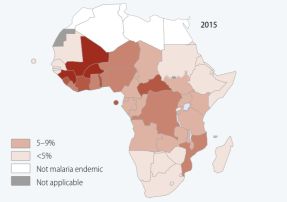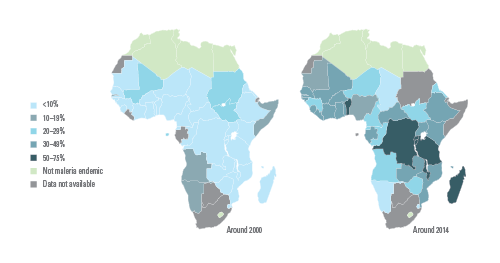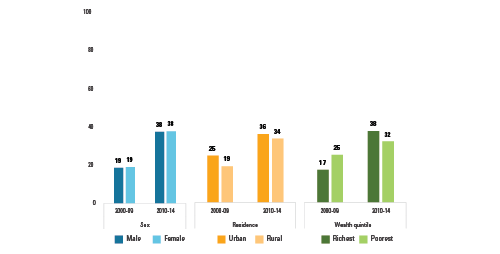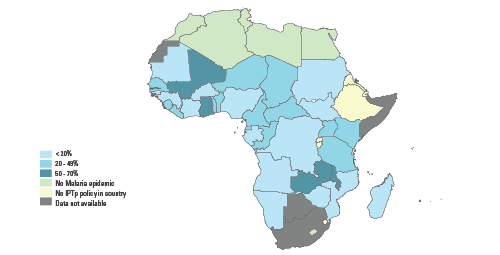The boundaries and names shown and the designations used on this map do not imply official endorsement or acceptance by the United Nations. Final boundary between the Republic of Sudan and the Republic of South Sudan has not yet been determined.
*Dotted line represents approximately the Line of Control in Jammu and Kashmir agreed upon by India and Pakistan. The final status of Jammu and Kashmir has not yet been agreed upon by the parties.
Malaria mortality among children under five is concentrated in sub-Saharan Africa
In 2015, malaria led to 438,000 deaths of which more than two-thirds were children under five years of age. This translates into a daily toll of more than 800 children under age 5—. Most of these deaths occurred in sub-Saharan Africa. However, progress in reducing malaria mortality among children has been encouraging. Since 2000, mortality rates among children under-five have fallen by 65%. An estimated 5.9 million child deaths have been averted
Despite this heavy toll, major inroads have been made against the disease as a result of stepped-up funding and programming. . Since 2000, global investment for malaria control has had a 20-fold increase. Domestic investments have also increased year on year. Funding increases have resulted in major advances against malaria. However, success is fragile and closely tied to sustained support.
In 2015, the global total of international and domestic funding for malaria control and elimination was $2.7 billion. However, the estimated annual spending requirement by 2030 is $8.7 billion.
PREVENTION
Sleeping under insecticide-treated mosquito nets (ITNs) on a regular basis is one of the most effective ways to prevent malaria transmission and reduce malaria related deaths. Since 2000, production, procurement and delivery of ITNs, particularly Long Lasting Insecticide Treated Nets (LLINs) have accelerated, resulting in increased household ownership and use. Since 2000, an estimated 1-billion ITNs have been distributed in Africa.
Household ownership of ITNs/LLINs is uneven across countries in the region. With an average coverage of over 50 per cent in sub-Saharan Africa – ranging from less than 30 per cent to more than 90 per cent – but most countries have made considerable progress in the past decade.
Over the last decade, the proportion of children sleeping under ITNs in sub-Saharan Africa increased from less than 5 per cent to almost 40 per cent, with large country and regional variations. For instance, while the percentage in sub-Saharan Africa as a whole was 36 per cent in 2013, coverage in Eastern and Southern Africa was 45 per cent and in West and Central Africa, 28 per cent.
All countries with trend data have shown major increases in ITN use by children. Despite this progress, overall use of treated mosquito nets falls short of the global target of universal coverage, and many children are not benefiting from this potentially life-saving intervention.
Most countries in Africa increased ITN use among children in an equitable way. This was largely due to free distribution campaigns that emphasized poor and rural areas. The success of this strategy has been reflected in an increased use of ITNs by vulnerable populations.
In Africa, 58 million people, or 8 per cent of the population at risk were protected from malaria through the use of indoor residual spraying in 2013. The global total for protected population was 123 million. However there has been some decrease since 2010 due to a withdrawal or downsizing of spraying programs in some regions.
CASE MANAGEMENT
Until recently, the ‘Proportion of children under 5 with fever who are treated with appropriate antimalarial drugs’ was the standard indicator for monitoring antimalarial treatment. However, it has become increasingly challenging to track trends following a 2010 WHO recommendation that advised universal use of diagnostic testing to confirm malaria infection before applying any treatment. As a follow up to this recommendation, many countries are now expanding the use of diagnostic testing to focus treatment on only those diagnosed with malaria. The current lower levels of antimalarial treatment in febrile children, therefore, may indicate that antimalarials are being provided only to confirmed cases. For more information on this issue, see the 2013 edition of the Household Survey Indicators for Malaria Control.
FIRST-LINE TREATMENT
Artemisinin-based combination therapy (ACT) is the most effective antimalarial therapy for P. falciparum, the most lethal malaria parasite and the one most pervasive in sub-Saharan Africa. By the end of 2014, most African countries, where Plasmodium (P.) falciparum is endemic, had adopted ACTs as national policy for first-line treatment. However, in surveys since 2010, only a relatively small proportion of children treated for malaria were actually receiving ACT. Although the practice is changing, other less effective antimalarial drugs are still commonly used to treat malaria.
Treatment of malaria in children with ACT is low in sub-Saharan Africa with just over one third of children treated with antimalarial drugs receiving the first-line drug. Lowest proportions – 21 per cent – are observed in West and Central Africa.
MALARIA DURING PREGNANCY
In African countries with high malaria transmission, pregnant women are highly vulnerable to malaria infection due to reduced immunity. When infected with malaria during pregnancy, they are more likely to become anaemic and give birth to low-birthweight or stillborn babies.
- Pregnant women sleeping under ITNs - Regular use of ITNs by pregnant women as well as intermittent preventive treatment during pregnancy are vital interventions in the prevention of malaria among pregnant women. Although some progress has been made, the proportion of pregnant women in sub-Saharan Africa who sleep under an ITN is too low. Some countries, however, including Benin, Guinea Bissau, Madagascar, Niger, Rwanda and United Republic of Tanzania, have managed to achieve coverage rates over 70 per cent since 2010.
- Intermittent preventive treatment during pregnancy (IPTp) - Preventing malaria in pregnant women through IPTp with sulfadoxine-pyrimethamine, which is administered during antenatal care visits, is an effective way of reducing maternal anaemia and low birthweight. Nearly every country in sub-Saharan Africa with a high malaria burden has adopted intermittent preventive treatment for pregnant women as part of its national malaria control strategy. In most countries coverage of antenatal care services is much higher than current levels of IPTp administration, suggesting that there are missed opportunities to expand access to this life-saving intervention for mothers and newborns.
In October 2012, WHO issued a new recommendation that extended treatment at every antenatal visit to all pregnant women in areas of moderate-to-high malaria transmission. Many countries are still in the process of scaling up this new recommendation. However, according to the data for the previous recommendation (of at least two doses of sulfadoxine-pyrimethamine during antenatal care), very few countries have achieved relatively high coverage level (50 to 70 per cent).
More than three fourths of pregnant women in sub-Saharan Africa don’t receive IPTp. This translates into about 28 million live births not protected against malaria in the region. Wealth is a major factor behind inequity in coverage of this important preventive treatment for pregnant women: 17% of women in the lowest wealth quintile receive IPTp as compared to 27% in the highest wealth quintile
REFERENCES
UNICEF, Progress for Children Beyond Averages: Learning from the MDGs, New York, 2015
Measure Evaluation, Measure DHS, President’s Malaria Initiative, Roll Back Malaria Partnership, UNICEF and WHO, 2013 Household Survey Indicators for Malaria Control.
President’s Malaria Initiative, 2014, Eighth Annual Report to Congress, Washington DC, April 2014.
Roll Back Malaria Partnership, A Decade of Partnership and Results, Progress & Impact Series, Report no. 7, WHO, Geneva, September 2011.
UNICEF, The State of the World’s Children 2015, UNICEF, New York, 2015.
WHO, Guidelines for the Treatment of Malaria: Second edition, WHO, Geneva, 2010.
WHO, World Malaria Report 2014, WHO, Geneva, 2013.












